Papers by Clandio Ruviaro
Ecological Indicators, 2016
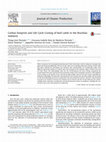
Journal of Cleaner Production, 2017
Efforts to improve the environmental performance of beef cattle often result in mitigation strate... more Efforts to improve the environmental performance of beef cattle often result in mitigation strategies that ignore the financial profitability. The aim of this study was to identify production systems of beef cattle that allow reducing the greenhouse gas emissions and, concomitantly, are economically viable. Four different production systems of a typical farm were analyzed in the southern region of Mato Grosso do Sul State, Brazil. The methodology used was the Environmental Life Cycle Costing, integrating the environmental Life Cycle Assessment and investment analysis tools. Production system IV, with slaughter of the animals at 20 months of age and 510 kg body weight, achieved the best results regarding the indicators profitability and emissions, reducing by 45% the emissions per kg of live weight and increasing by 38% the profitability per hectare compared to the base production system I. However, improvements in pastures are needed to increase the stocking rate per hectare and the average daily gain per animal, enabling lower emissions in production and greater financial returns to producers, avoiding the conversion of new areas into pastures for production.
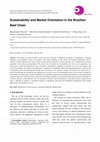
Journal of Agricultural Science and Technology, 2014
The demand for natural resources, energy and food facing the contemporary perception of sustainab... more The demand for natural resources, energy and food facing the contemporary perception of sustainability is imposing challenges to the productive sectors in accordance with market guidelines. In this context, the Brazilian agribusiness seeks to maintain external competitiveness and to satisfy growing domestic demands. In beef production, this competitiveness pervades traceability, food safety and sustainability. This article aims to identify the sustainability state of the art in agribusiness and characterize it within the Brazilian beef chain. Descriptive methodology, combining a literature review and a documentary data survey were adopted. An outline of the dimensions of agribusiness sustainability, drawn from benchmark practices, indicates that environmental, social and technological demands have become part of the industry's agenda. The data for beef cattle point to a growth in production but demonstrate that expansion has occurred in areas of environmental tension, which creates a demand for sustainability in the beef chain. A table of guidelines for sustainability demonstrates that although perceptions are not yet harmonized among the links in the whole beef chain, many of the technological guidelines for sustainable production may increase the producer's economic efficiency. In the Brazilian case, the increment of initiatives and dissemination of sustainable practices among the beef chain is desirable to provide a coordinated response of production, processing and distribution organizations facing market opportunities for sustainable livestock.
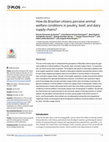
Plos One, 2018
The aim of this study was to understand the perceptions of Brazilian citizens about the general c... more The aim of this study was to understand the perceptions of Brazilian citizens about the general conditions of animal welfare in the poultry, beef, and dairy supply chains. To reach this aim, an online survey was conducted. The analysis was based on descriptive statistics and three logistic regression models. Results of descriptive statistics showed that citizens in Bra-zil had mostly negative perceptions about the conditions of animal welfare in the poultry, beef, and dairy supply chains. Results of the logistic regression models showed that citizens with a background in agricultural/veterinary sciences, and citizens who reported a higher level of knowledge about poultry and dairy supply chains were more likely to perceive the general conditions of animal welfare in these two supply chains as being bad. Citizens who reported previous contact with poultry farms were also more likely to perceive the general conditions of animal welfare in the poultry supply chain as being bad. In addition, the perception that farmers are mainly focused on the economic aspect of farming and less on animal welfare, the perception that animals do not have a good quality of life while housed on farms, and the perception that animals are not adequately transported and slaughtered, negatively impact on perceptions about the general conditions of animal welfare in the poultry , beef, and dairy supply chains.
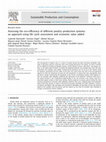
Sustainable Production and Consumption , 2020
The consumption of poultry meat as a source of animal protein has been increasing worldwide, espe... more The consumption of poultry meat as a source of animal protein has been increasing worldwide, especially in emerging countries' economies. Due to the growing demand for this protein, we seek to evaluate the eco-efficiency of poultry production systems, namely positive pressure, dark house, and organic systems, in the South region of Brazil. To achieve the proposed objective, two methods were used: life cycle assessment and economic value added, considering the functional unit of one kg of live chicken ready for slaughter, specifically from the cradle to farm gate. The results show that most of the environmental impacts are from the production of grains for the manufacture of animal feed and, consequently, from the electric energy consumed by the equipment of the aviaries. Conventional systems show negative results for economic value added/kg, evidencing the destruction of the producers' economic value, that is, the capital invested is not remunerated proportionally to the risk assumed in the activity, with environmental impacts similar as dark house systems. Poultry produced in organic systems showed the best economic performance (economic value added/kg). However, they cause a slightly greater environmental impact than other systems. In order to minimize uncertainties regarding the results obtained, a sensitivity analysis and Monte Carlo simulation were performed, identifying net operating revenue and invested capital as the variables with the greatest and least impacts on the value of economic value added/kg in all types of production systems analyzed.
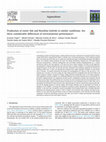
Aquaculture, 2019
In developing countries and tropical regions, earthen ponds have become an alternative for farmin... more In developing countries and tropical regions, earthen ponds have become an alternative for farming fish inland. Farmers usually restrict diet to compound feed, which is a relevant source of environmental impact. In the conditions described above, the motivation of this study was to evaluate the environmental impact of fish farming developed with different species. We evaluated systems producing the exotic Nile Tilapia (Oreochromis niloticus), the local hybrid Patinga (Piaractus mesopotamicus x Piaractus brachypomus) and local hybrid Surubim (Pseudoplatystoma sp. x Leiarius marmoratus). Species were bred separately, in the same farm and in similar conditions. The study was also inspired by the opportunity to properly pinpointing the most relevant reasons to explain variability of environmental performance among fish species. For this goal, we used the Life Cycle Assessment (LCA) technique, preparing our inventory by collecting realistic data, on farm, and restricting the evaluation from cradle-to-farmgate. Distinctive to many simulations in literature, we properly determined the nitrogen (N) and phosphorus (P) content of fish and feed in a bromatology Lab. To produce 1 ton of live weight, the exotic Tilapia performed considerably better than the Surubim in all impact categories evaluated. Compared to Patinga, Tilapia performed considerably better in two impact categories:
water dependence and land occupation. No considerable differences were observed between the two local hybrids. For the global warming potential, the acidification potential and the eutrophication potential, feed production and fish farming were the stages that contributed the most. In general, the source of protein in feed was the predominant source of environmental impact. Indeed, terrestrial animal co-products have more embodied resources in their tissue, due to diversifying and reasonably low feed conversion rates among fish species. However, the discussion spans towards trade-offs and the puzzling situation for decision making. This includes tunneling waste for aquaculture feed instead of dumping it on the landfill, or increasing the demand for terrestrial or marine ingredients by overbalancing in some direction. At the same time, the pathway towards sustainability of fish farming systems relies on finding alternative ingredients and managing genetic resource in order to improve feed conversion rates, empower and speed up production. For sure, these tasks demand efforts to meet the nutrient requirements of fish and offer feed with suitable composition. Overall, the methodology presented in this study can be used to compare and demystify environmental performances among local and exotic genetic resources.
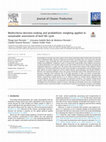
Journal of Cleaner Production, 2020
Environmental, economic and social aspects of the animal production phase of beef chain have been... more Environmental, economic and social aspects of the animal production phase of beef chain have been the focus of individual studies. However, integrated assessments are lacking. Thus, this study aims to develop an approach using sustainable life cycle assessment integrated to multicriteria methods of decision-making and probabilistic weighting in order to evaluate the sustainability of four different alternatives of animal production in the southern region of the state of Mato Grosso do Sul, Brazil. By presenting the integrated evaluation in a single score, the system with crop-livestock rotation (CLR) obtained a better performance. The better performance was due to the reduction in mechanization costs for planting and a high capacity of animal support per hectare without directly using phosphate and nitrogen fertilizers. However, by evaluating individual criteria, the pasture fertilization system (PFS) obtained the best performance regarding social indicators due to the high generation of jobs and worker remuneration. Probabilistic weighting in conjunction with the VIKOR (VIseKriterijumska Optimizacija I Kompromisno Resenje) multicriteria method proved to be an efficient solution to exempt human judgment from criteria weighting. This reduces the uncertainty of evaluation and allows a risk analysis considering all possible weight combinations in an integrated and individual way per criterion. However, studies on the development of new indicators related to systems, especially not evaluated criteria such as biodiversity, ecosystem services and animal welfare, are necessary to improve the evaluation of system sustainability.
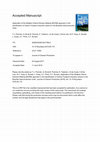
Journal Of Cleaner Production, 2018
Global awareness regarding the effects of Climate Change has led to a more restrictive society an... more Global awareness regarding the effects of Climate Change has led to a more restrictive society and demanding concerned with Greenhouse Gas Emissions associated with consumption. In this context, the livestock sector is seen as a major contributor to various impacts, as it is implemented throughout different climatic zones, with high variations in production and food systems, which, in turn, present direct impacts
on productivity and environmental externalities. In this context, the aim of this study was to rank possible improvement actions that allow the reduction of the Carbon Footprint originated from Brazilian beef
exports considering multiple criteria, from the identification of the impact profile associated with the final product. Thus, the Carbon Footprint was first estimated considering the production phase, in the Brazilian Central-West, and beef processing and transport until its delivery at three main final export destinations: Rotterdan, Shanghai and St. Petersburg. Subsequently, multicriteria decision-making methods were applied in order to quantify and rank possible improvement actions, with the joint application of the Fuzzy Set Theory and the TOPSIS method. Finally, the criteria are presented in the form of a SWOT (Strengths, Weaknesses, Opportunities and Threats) matrix for each evaluated alternative. The animal production stage represented the main impacts of Climate Change on the product system (over 96% for all export destinations) due to the digestive fermentation of the animals, leading to methane emissions. The option to implement improvement actions for the evaluated productive arrangement, the use of protein-energetic supplementation and pasture fertilization-rotation in the animal production phase, alongside the replacement of road transport units by more modern vehicles in the industrial phase, were identified as
alternatives that decrease the impact potential and facilitate the animal production phase. In this sense, the results point to possible improvements that, in addition to presenting low restrictions for implementation, can significantly reduce the beef Carbon Footprint. Improving Brazilian efficiency in terms of Carbon Footprint in this production chain can, in addition to provide a strategic differential concerning production and commercialization, contribute to reduce environmental impacts resulting from the sector at a global level. However, it is necessary to search for measures that facilitate the implementation of these actions, mainly at the rural producer level, considering both technical aspects and the qualification, training,
consulting and financial aspects, such as credit and subsidies, improving the environmental performance of this arrangement with a view to balancing it with the other dimensions.
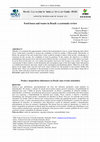
Desenvolvimento Socioeconômico em Debate, 2020
Globally, it is estimated that approximately a third of the food produced is lost or wasted. Redu... more Globally, it is estimated that approximately a third of the food produced is lost or wasted. Reducing half of these losses would make it possible to increase the availability of food for another 1 billion people. Specifically, in Brazil, the amount of lost and wasted food, if used, would be enough to achieve food security, considering as a restriction for this security, the availability of food for purchase. In this context, the objective is to identify methodologies that measure losses and food waste in Brazil. For this, a systematic review of the subject was made. It can be observed that there are a few studies that quantify food losses and wastage in the country. The largest concentration of these studies is in the distribution and consumption stages of the food supply chain. Information is available from food lost and waste, mainly in the consumption and distribution phases. Otherwise, in the other phases of the supply chain, food loss and waste values in Brazil are still incipient or non-existent. Studies that identify these values can contribute to the generation of more accurate information on the subject, being able to raise the values referring to food loss and waste of the country. Perdas e desperdícios alimentares no Brasil: uma revisão sistemática RESUMO Estima-se que, globalmente, aproximadamente um terço dos alimentos produzidos sejam perdidos ou desperdiçados. No entanto, a redução de metade dessas perdas tornaria possível aumentar a disponibilidade de alimentos para mais 1 bilhão de pessoas. Especificamente, no Brasil, a quantidade de alimentos perdidos e desperdiçados, se utilizados, seria suficiente para alcançar a segurança alimentar, considerando como uma restrição para essa segurança, a disponibilidade de alimentos para compra. Nesse contexto, o objetivo é identificar metodologias que mensurem perdas e desperdício de alimentos no Brasil. Para isso, foi realizada uma revisão sistemática do assunto. Pode-se observar que existem poucos estudos que quantificam perdas e desperdícios de alimentos no país. A maior concentração desses estudos está nos estágios de distribuição e consumo da cadeia de suprimento de alimentos. As informações estão disponíveis a partir de alimentos perdidos e desperdiçados, principalmente nas fases de consumo e distribuição. Nas demais fases da cadeia de suprimentos, os valores de perda e desperdício de alimentos no Brasil ainda são incipientes ou inexistentes. Estudos que identifiquem esses valores podem contribuir para a geração de informações mais precisas sobre o assunto, podendo elevar os valores referentes à perda e desperdício de alimentos no país. Palavras-chave: cadeia de suprimentos; segurança alimentar; sustentabilidade; fome.
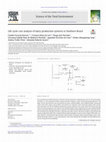
Science of the Total Environment, 2020
past decade has imposed great stress on the environment. Therefore, it is very important to find ... more past decade has imposed great stress on the environment. Therefore, it is very important to find a balance between economic, social, and environmental objectives. The paper assesses the economic costs by production systems: confined feedlot, semi-confined feedlot, and pasture in the south of the country. The economic assessment was realized on some investment analysis tools and the GHG emissions costs for the different production systems indicated. Our results show that hectare and the total area of rural properties were lower in the confined feedlot system, followed by the semi-confined feedlot system and pasture-based grazing system. However, the reduction of the need for feed inputs in the pasture system resulted in lower feeding costs when compared to the other systems. The hectare analysis suggested that the superior productivity of the semi-confined system conditioned higher emission costs in relation to the other systems. However, considered the total emissions of the systems, the pasture system obtained higher values, justified by the greater need for an area for production. The results showed that the higher the food efficiency of a system, the greater the profitability.
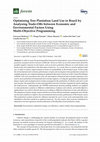
Forests, 2020
In order to meet the growing global demand for bioproducts, areas of forests planted for producti... more In order to meet the growing global demand for bioproducts, areas of forests planted for productive purposes tend to increase worldwide. However, there are several controversies about the possible negative impacts of such forests, such as invasive potential, influence on water balance and biodiversity, and competition with other types of land use. As a result, there is a need to optimize land use, in order to achieve improvements in terms of sustainability in the broadest sense. In this study, the environmental and economic performances of pine and eucalyptus forest production systems for multiple purposes are compared aiming an optimized allocation of land use in the Center-West Region of Brazil. Life cycle assessment, life cycle cost and analysis of financial and economic indicators were used to assess potential environmental and economic impacts, covering the agricultural and industrial phases of pine and eucalyptus forest systems managed for the production of cellulose and sawn wood and, for pine, the production of rosin and turpentine from the extraction of gumresin and by applying the kraft process. Subsequently, the TOPSIS multicriteria decision-making method was applied to rank production systems in different combinations of phases and criteria, and multi-objective optimization was used to allocate land use according to different restrictions of areas and efficiency. The adoption of cleaner energy sources and the use of more efficient machines, equipment and vehicles are the main solutions to improve the environmental and economic performance of the forestry sector. The production systems of pine for cellulose and pine for sawn wood, rosin and turpentine were identified as the best solutions to optimize land use. For this reason, they must be considered as alternatives for the expansion and diversification of the Brazilian forest productive chain.
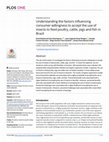
Plos One, 2020
The aim of this study is to investigate the factors influencing consumer willingness to accept th... more The aim of this study is to investigate the factors influencing consumer willingness to accept the use of insects to feed poultry, cattle, pigs, and fish. To reach this objective, we conducted an online survey with Brazilian consumers. 600 questionnaires were collected. We analyzed data using descriptive statistics and logistic regression models. In general, the use of insects to feed poultry, pigs and cattle was not widely accepted. A more widely acceptance was found for the use of insects to feed fish. The results of logistic regressions models show that positive attitudes are associated with a higher probability of accepting the use of insects to feed poultry, pigs, cattle, and fish. Perceived benefits were associated with a higher likelihood of accepting the use of insects to feed fish. However, perceived benefits were also associated with a lower likelihood of accepting the use of insects to feed poultry. Perceived challenges were associated with a higher likelihood of accepting the use of insects to feed poultry. However, perceived challenges were associated with a lower likelihood of accepting the use of insects to feed pigs.
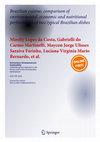
Environment, Development and Sustainability, 2020
Brazilian cuisine is influenced by the diversity of geographical conditions, production of local ... more Brazilian cuisine is influenced by the diversity of geographical conditions, production of local ingredients and the multicultural character of foreign and native folks. In view of this context, we analyze sustainability issues in relation to the preparation of rice with jerky (“Arroz carreteiro”), and rice with chicken (“Galinhada”). This study is divided into two stages: environmental and economic analysis of the food production process by life cycle analysis and nutritional assessment in comparison with the recommendations of the Worker’s Feeding Program (PAT) issued by the Ministry of Labor and Employment. In environmental terms, while a portion of Arroz carreteiro emits 2.08 kg of CO2eq, a portion of Galinhada emits 1.34 kg CO2eq. Regarding acidification potential, the value found for Arroz carreteiro was 0.028 kg SO2eq and for Galinhada was 0.011 kg SO2eq. Regarding eutrophication potential, the value for Galinhada was 0.005 kg PO4eq and for Arroz carreteiro was 0.014 kg PO4eq. In economic terms, Galinhada has a lower cost than Arroz carreteiro. Regarding the nutritional aspect, both preparations presented values close to those recommended by the PAT. However, both preparations exceeded the protein needs and Galinhada
exceeded sodium needs. The content of fibers was low, reaching only around 20% of the PAT. The results of the dishes analyzed are consistent with the values found in similar environmental studies with regard to CO2eq emissions, and they provide good amounts of nutrients as required for a main meal. However, they need to be balanced with other preparations to reach the values recommended.
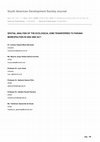
South American Development Society Journal, 2020
The replacement of natural vegetation was the way by which certain food crops could be produced i... more The replacement of natural vegetation was the way by which certain food crops could be produced in different regions of Brazil. The state of Paraná has undergone such process of replacing its natural vegetation, but the state is considered a pioneer in the adoption of a measure entitled Ecological ICMS for biodiversity. The aim is to promote the conservation of natural vegetation by creating conservation units and preserving water sources that supply the population living in the municipality and in other locations. The objective of this study is to perform a spatial analysis of the transferring of Ecological ICMS resources per municipality of the state of Paraná in 2000 and 2017. These years comprise the period with availability of information. Spatial data analysis was used as methodology. Data refer to the amounts of Ecological ICMS transferred to the municipalities during the years of analysis, the origin of the resources, and their share in the total revenue of these municipalities. The results indicate that the number of municipalities that received Ecological ICMS increased between the first and the last year of analysis. The main source of collection is the creation of conservation units. In addition, the eastern macroregion of the state of Paraná concentrates the municipalities with the highest share of income provided by this tax.
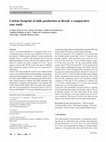
The International Journal of Life Cycle Assessment, 2014
Purpose Livestock production is a recognized source of environmental impact, and this sector indi... more Purpose Livestock production is a recognized source of environmental impact, and this sector indirectly involves approximately 5 million people in Brazil. Livestock production includes nearly 1.5 million milk producers that use several different production systems. We chose the southern region of Brazil to evaluate the carbon footprint (CF) per 1 kg of energy-corrected milk (ECM) at the farm gate for different dairy production systems with the use of a good level of technology. Methods The dairy production systems were confined feedlot system, semi-confined feedlot system (including some grazing), and pasture-based grazing system. A sensitivity analysis of the dry matter intake (DMI) in each farming system and an uncertainty analysis based on a Monte Carlo (MC) simulation were performed to complement the discussion. The standards ISO 14040: 2006 and ISO 14044: 2006 were used for the comparative life cycle assessment (LCA) focused on the CF. The LCA software tool SimaPro 7.3.3 was used. Sensitivity analyses were conducted on input data for total digestible nutrients (TDN) and crude protein (CP) based on values from the literature.
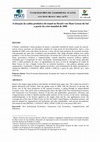
RESUMO O Brasil, considerado o maior produtor de açúcar e exportador mundial de etanol a partir d... more RESUMO O Brasil, considerado o maior produtor de açúcar e exportador mundial de etanol a partir da cana-de-açúcar, tem-se mostrado um laboratório mundial em larga escala de biocombustíveis. Após a crise mundial de 2008, com a descoberta do pré-sal, o setor, um dos mais prósperos da economia nacional, vem passando por uma crise econômica sem precedentes. Este artigo pretende analisar essa cadeia produtiva, à luz da Nova Economia Institucional e Economia dos Custos de Transação, das teorias da firma, governança, eficiência e competitividade, visando identificar possíveis políticas públicas orientadas para a recuperação do setor. Analisando, metodologicamente, à luz das teorias aplicadas sobre a cadeia produtiva da cana e as agroindústrias do setor, na área de abrangência do estado de Mato Grosso do Sul, à Região Centro-Sul, no território brasileiro; e das políticas adotadas pelas organizações e instituições e demais agentes envolvidos, com levantamentos de dados documentais e estatíst...
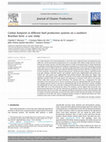
Journal of Cleaner Production, 2015
The carbon footprint (CF) of beef production is one of the most widely discussed environmental is... more The carbon footprint (CF) of beef production is one of the most widely discussed environmental issues within the current agricultural community due to its association with climate change. Because of these relevant and serious concerns, the beef cattle industry is under increasing pressure to reduce production or implement technological changes with significant consequences in terms of beef marketing. The goals of this study were to evaluate the CF per 1 kg of live weight gain (LWG) at the farm gate for different beef production systems in the southern part of Brazil. Aberdeen Angus beef-bred cattle were assigned to one of seven categories: natural grass; improved natural grass; natural grass plus ryegrass; improved natural grass plus sorghum; cultivated ryegrass and sorghum; natural grass supplemented with protein mineralised salt; and natural grass supplemented with protein-energetic mineralised salt. Monte Carlo analysis was employed to analyse the effect of variations of dry matter intake digestibility (DMID), total digestible nutrients (TDN) and crude protein (CP) parameters in methane (CH 4 ) enteric, CH 4 manure, nitrous oxide (N 2 O) manure and N 2 O N-fertiliser. The method used was a comparative life cycle assessment (LCA) centred on the CF. The CF varied from 18.3 kg CO 2 equivalent/kg LWG for the ryegrass and sorghum pasture system to 42.6 kg CO 2 equivalent/kg LWG for the natural grass system, including the contributions of cows, calves and steers. Among all grassland-based cattle farms, production systems with DMID from 52 to 59% achieved the lowest CO 2 emissions and the highest feed conversion rate, thereby generating lower CH 4 and N 2 O emissions per production system. Because the feed intake and feed conversion rate are one of the most important production parameters in beef cattle production with an obvious risk of data uncertainty, accurate feed data, which include quantity and quality, are important in estimates of CF for LWG. The choice of adequate feeding strategies to mitigate greenhouse gas (GHG) emissions may result in better environmental advantages.

The green marketing strategies attempt to assign greater value to products highlighting their asp... more The green marketing strategies attempt to assign greater value to products highlighting their aspects related to preservation of the environment and sustainability. The present study sought to verify whether the application of the green marketing strategies in the marketing of organic products aggregates, in consumer perception, greater value to food products. The study was conducted in three stages with distinct methodological nature and character, in which it sought to identify the provision of consumers to pay more for organic products, understand the reasons why there is or is not available and discuss the strategies used in the marketing of these products. The results demonstrated that the green marketing strategies applied on the marketing of organic products really created greater value in the design of a good part of the consumers, and that a considerable portion of them, demonstrates willingness to pay an additional amount to consume such products. However, many of these co...
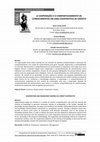
Organizations today are inserted in a context of extreme competitiveness and need the sharing and... more Organizations today are inserted in a context of extreme competitiveness and need the sharing and creation of knowledge to generate innovation, aiming at sustainability in the market. Relating the knowledge sharing cooperation, this paper aims to discuss the possible relationship between cooperation and knowledge sharing between individuals in a competitive scenario. Through a literature search was possible to discuss some points of cooperation both between individuals, such as the sharing of knowledge between them. In order to deepen the theme was also applied an exploratory research with unstructured interviews with the employees of a credit cooperative inserted in the state of Mato Grosso do Sul. According to the proposed methodology, the cooperation and knowledge sharing are related to a competitive scenario, since the cooperation depends on the sharing of knowledge to exist and the own sharing of knowledge, requires the cooperation among the agents to happen.
Revista Brasileira de Gestao e Desenvolvimento Regional








Uploads
Papers by Clandio Ruviaro
water dependence and land occupation. No considerable differences were observed between the two local hybrids. For the global warming potential, the acidification potential and the eutrophication potential, feed production and fish farming were the stages that contributed the most. In general, the source of protein in feed was the predominant source of environmental impact. Indeed, terrestrial animal co-products have more embodied resources in their tissue, due to diversifying and reasonably low feed conversion rates among fish species. However, the discussion spans towards trade-offs and the puzzling situation for decision making. This includes tunneling waste for aquaculture feed instead of dumping it on the landfill, or increasing the demand for terrestrial or marine ingredients by overbalancing in some direction. At the same time, the pathway towards sustainability of fish farming systems relies on finding alternative ingredients and managing genetic resource in order to improve feed conversion rates, empower and speed up production. For sure, these tasks demand efforts to meet the nutrient requirements of fish and offer feed with suitable composition. Overall, the methodology presented in this study can be used to compare and demystify environmental performances among local and exotic genetic resources.
on productivity and environmental externalities. In this context, the aim of this study was to rank possible improvement actions that allow the reduction of the Carbon Footprint originated from Brazilian beef
exports considering multiple criteria, from the identification of the impact profile associated with the final product. Thus, the Carbon Footprint was first estimated considering the production phase, in the Brazilian Central-West, and beef processing and transport until its delivery at three main final export destinations: Rotterdan, Shanghai and St. Petersburg. Subsequently, multicriteria decision-making methods were applied in order to quantify and rank possible improvement actions, with the joint application of the Fuzzy Set Theory and the TOPSIS method. Finally, the criteria are presented in the form of a SWOT (Strengths, Weaknesses, Opportunities and Threats) matrix for each evaluated alternative. The animal production stage represented the main impacts of Climate Change on the product system (over 96% for all export destinations) due to the digestive fermentation of the animals, leading to methane emissions. The option to implement improvement actions for the evaluated productive arrangement, the use of protein-energetic supplementation and pasture fertilization-rotation in the animal production phase, alongside the replacement of road transport units by more modern vehicles in the industrial phase, were identified as
alternatives that decrease the impact potential and facilitate the animal production phase. In this sense, the results point to possible improvements that, in addition to presenting low restrictions for implementation, can significantly reduce the beef Carbon Footprint. Improving Brazilian efficiency in terms of Carbon Footprint in this production chain can, in addition to provide a strategic differential concerning production and commercialization, contribute to reduce environmental impacts resulting from the sector at a global level. However, it is necessary to search for measures that facilitate the implementation of these actions, mainly at the rural producer level, considering both technical aspects and the qualification, training,
consulting and financial aspects, such as credit and subsidies, improving the environmental performance of this arrangement with a view to balancing it with the other dimensions.
exceeded sodium needs. The content of fibers was low, reaching only around 20% of the PAT. The results of the dishes analyzed are consistent with the values found in similar environmental studies with regard to CO2eq emissions, and they provide good amounts of nutrients as required for a main meal. However, they need to be balanced with other preparations to reach the values recommended.
water dependence and land occupation. No considerable differences were observed between the two local hybrids. For the global warming potential, the acidification potential and the eutrophication potential, feed production and fish farming were the stages that contributed the most. In general, the source of protein in feed was the predominant source of environmental impact. Indeed, terrestrial animal co-products have more embodied resources in their tissue, due to diversifying and reasonably low feed conversion rates among fish species. However, the discussion spans towards trade-offs and the puzzling situation for decision making. This includes tunneling waste for aquaculture feed instead of dumping it on the landfill, or increasing the demand for terrestrial or marine ingredients by overbalancing in some direction. At the same time, the pathway towards sustainability of fish farming systems relies on finding alternative ingredients and managing genetic resource in order to improve feed conversion rates, empower and speed up production. For sure, these tasks demand efforts to meet the nutrient requirements of fish and offer feed with suitable composition. Overall, the methodology presented in this study can be used to compare and demystify environmental performances among local and exotic genetic resources.
on productivity and environmental externalities. In this context, the aim of this study was to rank possible improvement actions that allow the reduction of the Carbon Footprint originated from Brazilian beef
exports considering multiple criteria, from the identification of the impact profile associated with the final product. Thus, the Carbon Footprint was first estimated considering the production phase, in the Brazilian Central-West, and beef processing and transport until its delivery at three main final export destinations: Rotterdan, Shanghai and St. Petersburg. Subsequently, multicriteria decision-making methods were applied in order to quantify and rank possible improvement actions, with the joint application of the Fuzzy Set Theory and the TOPSIS method. Finally, the criteria are presented in the form of a SWOT (Strengths, Weaknesses, Opportunities and Threats) matrix for each evaluated alternative. The animal production stage represented the main impacts of Climate Change on the product system (over 96% for all export destinations) due to the digestive fermentation of the animals, leading to methane emissions. The option to implement improvement actions for the evaluated productive arrangement, the use of protein-energetic supplementation and pasture fertilization-rotation in the animal production phase, alongside the replacement of road transport units by more modern vehicles in the industrial phase, were identified as
alternatives that decrease the impact potential and facilitate the animal production phase. In this sense, the results point to possible improvements that, in addition to presenting low restrictions for implementation, can significantly reduce the beef Carbon Footprint. Improving Brazilian efficiency in terms of Carbon Footprint in this production chain can, in addition to provide a strategic differential concerning production and commercialization, contribute to reduce environmental impacts resulting from the sector at a global level. However, it is necessary to search for measures that facilitate the implementation of these actions, mainly at the rural producer level, considering both technical aspects and the qualification, training,
consulting and financial aspects, such as credit and subsidies, improving the environmental performance of this arrangement with a view to balancing it with the other dimensions.
exceeded sodium needs. The content of fibers was low, reaching only around 20% of the PAT. The results of the dishes analyzed are consistent with the values found in similar environmental studies with regard to CO2eq emissions, and they provide good amounts of nutrients as required for a main meal. However, they need to be balanced with other preparations to reach the values recommended.